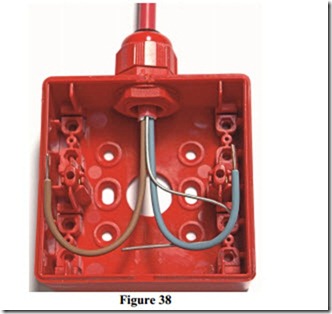Fire Performance Cables
There is a number of fire performance cables on the market. The types most commonly used in the last ten to twenty years are sometimes referred to as soft skinned cables. This basically means that they differ from the original copper sheathed mineral insulated cable, in that they are flexible and easily terminated. The correct selection and installation of these safety cables is extremely important.
Construction of Fire Performance Cables
Fire performance cables have copper conductors insulated with a high temperature insulation such as Silicone rubber or Insudite. The protective conductor is tinned copper of the same CSA as the insulated conductors. The type shown in Figure 37 has an electrostatic screen, which consists of a laminated aluminum tape bonded to the sheath. This screen is in contact with the bare protective conductor. It is therefore suitable for use where ( EMI ) Elecromagnetic Interference is a threat.
The sheath consists of a robust thermoplastic, which emits Low Smoke and Zero Halogen is Flame Retardant ( LSOH-FR ). This means that both toxic and acidic gases and smoke generation are minimised in the event of a fire. The sheath is available in Red or White. Other colours are available as a special order. It is manufactured in the usual range of conductor sizes up to 4 mm2.
Application of Fire Performance Cables
These cables are for use on systems, which must remain operational for a particular duration, in the event of a fire. The cable may not survive the fire. There should be no damage to health or property by acid or corrosive fumes. There should be no propagation of fire from one location to another. If the fire source is removed the cable should self-extinguish. There should be sufficient visibility for evacuation of occupants and for fire fighting.
They are used on:
· Fire alarm systems
· Public address systems
· Emergency lighting systems
· Closed circuit television systems
Some types are suitable for use in any temperature between -40°C and +80°C, while others are limited to temperatures between -20°C and +60°C
Installation of Fire Performance Cables
Fire performance cable should be installed in continuous lengths. Avoid having to make joints in the cable. Avoid damage to the cable, by unrolling it from the reel. Do not bend it too sharp. It can be fixed directly onto walls using special LSOH coated copper clips. These may be fixed in the usual manner or if desired using modern gas nailing technology. Plastic type clips must not be used. If several cables are to follow the same route they may best be supported on a cable tray or rack system. Plastic cable ties must not be used, particularly where cables are fixed to the underside of the tray. It is essential that fire resistant cable ties ( stainless steel ) are used. The minimum internal bend radius is found by multiplying the overall diameter of the cable by a factor of 6. It should not be worked below 0°C.
Termination of Fire Performance Cables
There are no special tools required for terminating this cable.
Listed below are the steps to be followed when terminating fire performance cable:
· Fix gland in position in enclosure and tighten.
· Decide the point to which the cable sheath must be removed ( must protrude 5-10 mm beyond the gland into the enclosure to protect the insulation )
· Cut around the circumference of the cable being careful not to cut the screen
· Bend the cable at this point and pull off the sheath ( complete with screen for most types, a longitudinal cut of the sheath is not necessary ).
· Remove screen to same point ( where not bonded to the cable sheath ).
· Loosen gland nut back fully, enter cable into gland and work through rubber seal ( cable sheath should appear 5–10 mm inside enclosure )
· Bare the required length of the conductor with the help of suitable stripping pliers.

